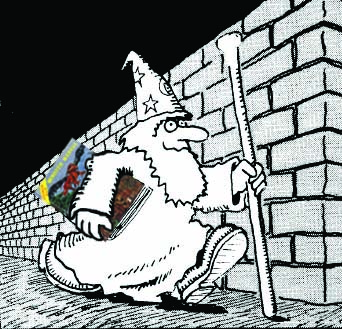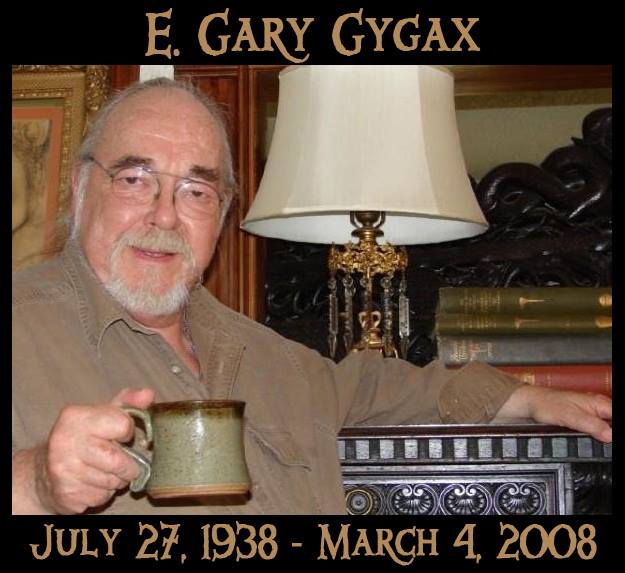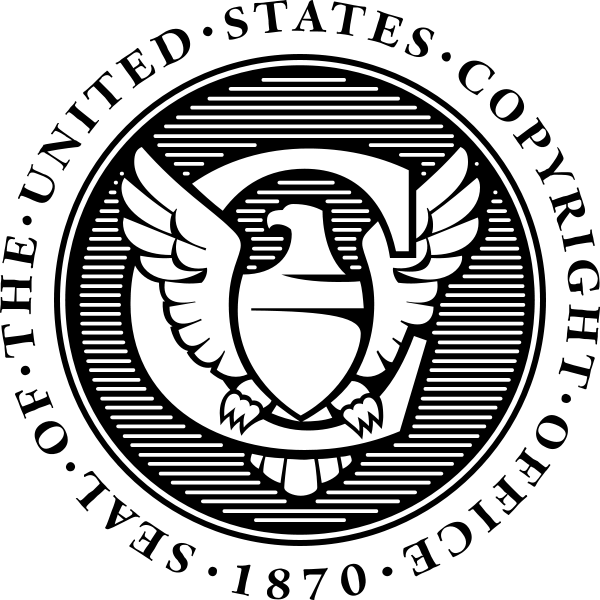
<>

<>
The various creatures contained
herein are for use in AD&D.
Parameters have been set
for that game. Those monsters drawn from my original work have been
revised and expanded upon
accordingly. Except as noted, all new monsters are strictly of this
author's creation -just
as all those which appeared in The Strategic Review were -and I take
the burden of full responsibility
for them. It is necessary to acknowledge the contributions of the
following persons:
Steve Marsh for devising
the creatures for undersea encounters which originally appeared in BLACKMOOR,
as I have radically altered them herein;
Erol Otus for doing the
preliminary work and illustrations of the anhkheg and remorhaz which appeared
in The
Dragon; Ernie Gygax for
the water weird and for his help in solidifying many of the characteristics
of the creatures herein;
Terry Kuntz, who was never thanked for his prototypical beholder, a
revised version of which
was included in GREYHAWK;
to the whole crew at TSR, and to Brian
Blume, Tim Kask, and Dave
Sutherland in particular, is due thanks for helping me get this whole
project into a manuscript;
and to my wife, Mary, who has been stuck with the iob of typing most
of the manuscript, my apologies
for mistakes needing correcting and my admiration for staying
with it day after day. If
I have missed thanking any other person, please pardon the oversight.
-
E. Gary Gygax
-

1d10+?
Gaze attacks 130.70
humanoid > 11 INT
will choose most effective UA (dmg 73
< 10 INT 1-2 P, 3-4 G, 5-6 O
This book is protected under the copyright laws of the United States of America.

Any reproduction or other unauthorized use of the material or artwork contained herein is prohibited without the express written permission of TSR Hobbies, Inc. <>
Colored version of original art: Mr. Patton
<what is his 1st name?>
Richard Scott

<clear permission for
image use for final version. this man's work is the best I've seen>
<remember to set the author field back to Gary Gygax>
oldschooler wrote:
Why the split up of Medusa
from "gorgon"?
Why change basilisk from
a cockatrice to an eight legged lizard?
Why name all winged horses
Pegasas?
Why the rubbery, regenerating
trolls and not the more familiar trolls of Scandinavian myth?
I think you see where this is going...
Were there specific reasons for ignoring "history" is some cases or outright changing that which is familiar to fantasy buffs?
-
-

Why not right back at you!
there is no definative authority regarding fabulous monsters. For example,
a medieval bestiary shows the gorgon as a metal-scaled bull as I gave in
the AD&D MM.
Difference is good, because that means players can't be certain what they are facing--until they have fought and overcome the critter in question.
Cheers,
Gary
oldschooler wrote:
Anywho, regarding your first
big project of the seventies, I read earlier that you wrote G1-3 after
the PHB, but before the DMG, which indicates the DMG was more or less a
book of all optional rules to be concidered by individual DMs. Forgive
me for bringing up a game that "doesn't belong to you", but it sounds like
for AD&D, the MM & PHB are more or less the official rules to follow,
whereas the DMG is something more of an options book for enterprising Dungeon
Masters (with age vs. abilities, unarmed combat, artifacts & relics,
etc.) to use. Was that your intent as you remember it? I ask because is
seems that's the way Troll Lord Games is going with their Castles &
Crusades books and I thought it would be an interesting comparison.

I took a break from
rules writing to do those modules.
Much of the materirial contained
in the DMG is as integral to the AD&D
game as what is found in the MM and PHB--more
so, in fact, that the MM's content,
that being only stats and
details for opponents of the PCs and thus completely mutable ![]()
Cheerio,
Gary
Quote:
Originally Posted by talinthas
hey gary, i've always wanted
to know this- Why did you release the 1st edition AD&D monster manual
before the other two books?

I decided to create the
MM
as the initial part of the new AD&D system
because it would be usable by all the D&D
players,
and the entry information
in the book would whet appetites for the new rules.
It was also the easiest
one to put together,
since I had been doing penciled-in
new system stat sheets for all the old monsters,
as well as writing up a
lot of new ones.
I had a box in my office,
and I'd toss the rough stat
sheets into it each day.
Mike Carr would collect
them and type them up--or have someone else do it,
so in no time at all there
was sufficient material for the MM even as I was developing the whole of
the material for the system, beginning on the PHB.
Cheers,
Gary
Quote:
Originally Posted by S'mon
Hi Gary - indeed there are
many differences between D&D humanoids and Tolkien's humanoids, and
many creatures created from whole cloth as well as some inspired by other
sources. I like the wide variety of creatures seen in the Monster Manual
& Monster Manual II - it's notable that IMO these actually show more
variation than the Fiend Folio, even though that had a multiciplicity of
different authors there's much more duplication therein.
G'day S'mon)

The variety of monster choices,
even those in the FF, should be appreciated by all DMs who are populating
dungeons and similar settings. For other environments, about 10 normal
animals, 20 ordinary monsters and 10 special ones should serve pretty well.
Almost all of the additions I made to the base roster used in D&D were
for dungeon crawls and special encounters in modules so as to keep the
players guessing or to challenge the powerful PCs.
I have to laugh at myself
in that regard. About three years back I was playing in an OAD&D game
and a wind walker was encountered.
Damned if I could remember
just how to attack the critter effectively, so my PC ran away, managed
to escape while it was busy attacking others.
Cheers,
Gary
Quote:
Originally Posted by Mythmere1
Actually, I do have a question.
In the early days just after publishing the first hardback (I don't know
if it was the MM or the PH - they were both out when I started playing,
but not the DMG), how chaotic was it?

The first hardbound AD&D
book was the MM published in 1977.
Things at the office were hectic but not chaotic. We were all crowded into an old house, a game shop taking up much of the ground floor, shipping in the former kitchen, inventory on the front porch and in the basement, and the offices upstairs on the first floor.
Quote:
Originally Posted by Mythmere1
There must have been a severe
shortage of cash to get out the hardbacks and the little 1-3 level monsters
and treasure books, while also funding Dragon. How did you manage that?
Was new money coming in, or were you publishing new books with the proceeds
of the published ones. At what point did you realize that the country was
going to buy everything that you could afford to print, and how did you
react to the realization that D&D was going to be a craze of nationwide
magnitude? Fear? Excitement? Repeated glances at checkbook? Frenzied bouts
of authorial effort? Did it affect quality control on any of the books
or products in your opinion?

At that time I was the actual
CEO of TSR, and money was tight because we had to reprint D&D works
and produce new material at the same time, even as we paid employees. Sales
were good, so cash flow was key. We borrowed some short-term cash to produce
smaller products, and raised funds by offering lifetime subs to the DARGON
and also to new game products. While the zine was then a cash drain, the
goodwill and advertising/promition were more than a counter-balance.
It was in 1976 that we recognized that the game was going to be a growing one, and planned accordingly. I kept long term debt to about the amount of revenue the company generated in a month, and so the operation was very profitable. Not many customers were slow in paying, as they wanted to keep getting restocks and new product, so cash flow was good.
The main thing that affected quality control was lack of personnel and the need to get product into the pipeline or face outraged consumers. In all, I believe we did a very fine job all things considered.
Cheers,
Gary
Quote:
Originally Posted by francisca
Hey Gary-
Hope Groundhog Day found you in improving health.

Thanks. I feel pretty well.
the problem is that i tire out after about an hour, and game design calls
for extended periods of hard concentration and work at the keyboard.
Quote:
Originally Posted by francisca
My question concerns the
original Monster Manual. being the first hardback RPG book ever published,
did you have difficulty securing a printer for it? Were folks in the industry
leery of such an expenditure for such a relatively new game? Or was it
simply an exercise in waving enough capital in their faces? Also what circumstances
led to Random House being the distributer?
Thanks!

We has the dunds on hand
to pay the printer for the initial 50,000 copies of the Monster Manual
that were ordered. It was no problem finding a printer thst could do a
stitched binding and school-book cover material either, as i wanted the
AD&D volumes to be as nearly indestructable as could be managed. Later
on the Blumes changed that so save a nickle or two on each copy printed...as
if we weren't making enough as it was.
Crown books wanted me to write a special introductory game book exclusively for them. that was a no-go. Simon & Schuster contacted me about book trade distribution, but they were going to take a year to set it up, so i wasn't too thrilled. Then I got a phone call from Mildred Marmur, then the VP of Sub-Rights Licensing at Random House. they flew me out to NYC the next week and were ready to begin distribution in a month's time. As the remainder of the deal I negotiated assured TSR cash flow and other great benefits, i signed my name up there in their offices on the second day of our meetings.
Having Millie as an advocate
was a lot of help in cutting a great deal for TSR.
Both of her sons were D&Ders
Cheers,
Gary

There were a number of whimsical
books dealing with folklore done back in the 1960s, and I made use of several
when creating AD&D critters.
I don't believe that I ran
across The Book of Weird, though.